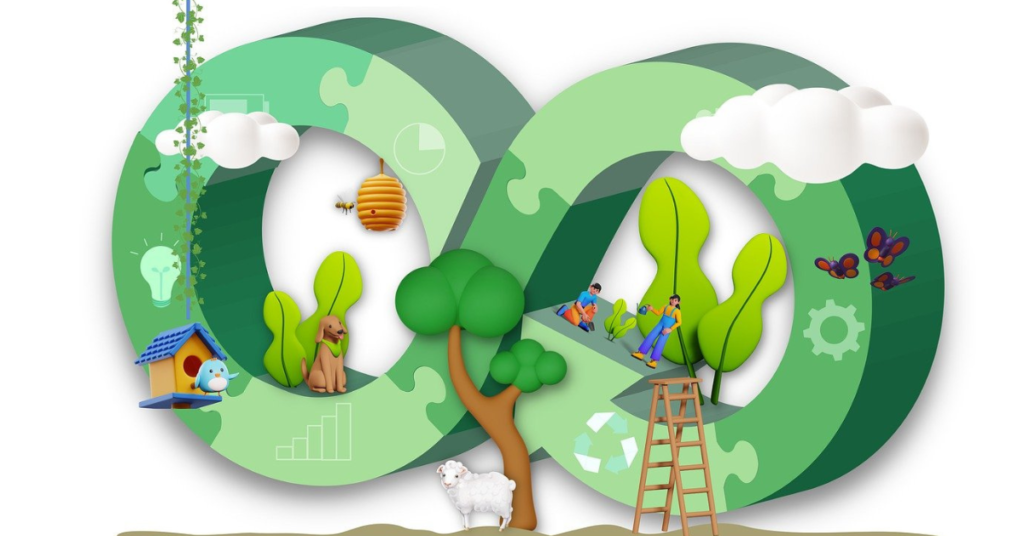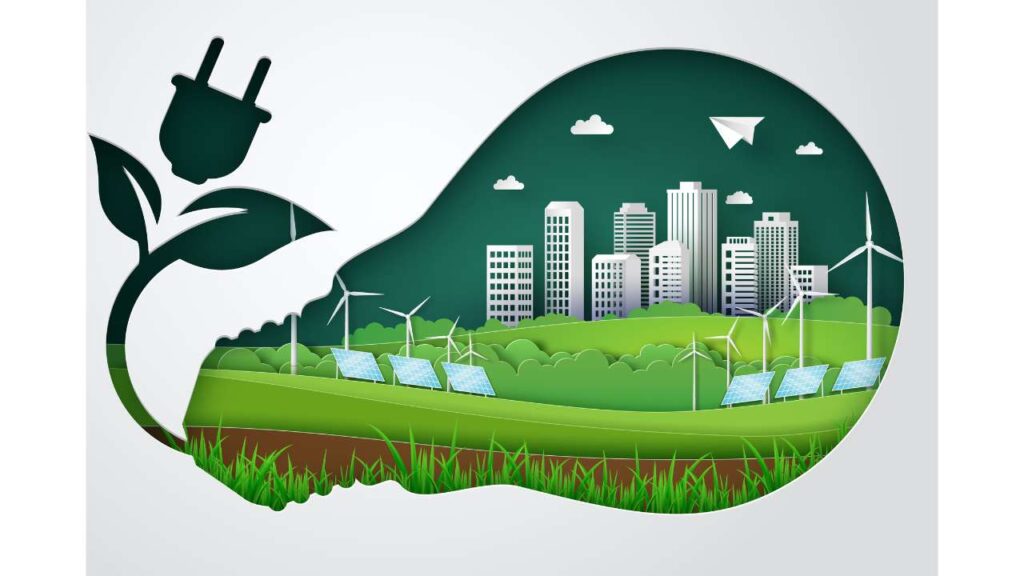Detail study on environmental sustainability | We Care Earth |
What is Sustainable Environment? How can we achieve it?
Environmental sustainability refers to a broad and complex concept, but at its core, it’s about living in a way that meets the needs of the present without compromising the ability of future generations to meet their own needs. It involves finding a balance between economic, social, and environmental considerations to ensure the long-term health and vitality of the planet.

Things to keep in mind about environmental sustainability:
- It’s a global issue that requires international cooperation.
- It’s an ongoing process that requires continuous improvement.
- It’s not just about individual actions; it’s also about systemic change.
- Everyone has a role to play, from individuals to businesses to governments.
Table of Contents
1. Conservation of Resources
The conservation of resources refers to the sustainable use and management of natural resources to ensure their availability for current and future generations. It involves responsible practices aimed at minimizing waste, promoting efficiency, and maintaining ecological balance. Conservation efforts can apply to various types of resources, including:
1. Energy:
Energy conservation is a critical component of environmental sustainability, focusing on the responsible and efficient use of energy resources. This practice is crucial for reducing the environmental impact of human activities, mitigating climate change, and ensuring a sustainable energy future. Here’s a detailed breakdown of the key aspects related to the conservation of energy resources :
Efficient Energy Use:
- Purpose: The primary goal of energy conservation is to optimize the use of energy in various sectors, including residential, commercial, and industrial. This involves using energy-efficient technologies and practices to achieve the same or improved level of service while minimizing energy consumption.
- Examples: Upgrading buildings with better insulation, using energy-efficient appliances, and implementing smart technologies like programmable thermostats all contribute to efficient energy use.

Renewable Energy Transition:
- Purpose: Transitioning to renewable energy sources is a fundamental aspect of energy conservation. Unlike finite fossil fuels, renewable sources such as solar, wind, and hydro power are sustainable, produce fewer greenhouse gas emissions, and contribute to a more resilient and decentralized energy infrastructure.
- Examples: Installing solar panels on rooftops, harnessing wind power through wind turbines, and utilizing hydropower from rivers or tides are examples of transitioning to renewable energy sources.
Solar Power:
- Purpose: Solar energy is harnessed from the sun and is a clean and abundant source of renewable power. Solar technologies, including photovoltaic cells and solar thermal systems, capture sunlight and convert it into electricity or heat for various applications.
- Examples: Residential and commercial solar panels on rooftops, solar-powered streetlights, and large-scale solar farms contribute to the utilization of solar power.
Wind Power:
- Purpose: Wind power involves capturing the kinetic energy of the wind to generate electricity. Wind turbines, both onshore and offshore, are used to convert the mechanical energy of the wind into electrical power.
- Examples: Wind farms with multiple turbines, often located in areas with consistent wind patterns, contribute to the generation of clean and sustainable wind power.
Hydropower:
- Purpose: Hydropower utilizes the energy of flowing or falling water to generate electricity. It is one of the oldest and most widely used forms of renewable energy, providing a reliable and consistent source of power.
- Examples: Dams and hydroelectric power plants on rivers and water reservoirs generate electricity by harnessing the energy of moving water.
Benefits of Conservation and Renewable Energy:
- Environmental Impact: Conservation of energy and the use of renewable sources reduce reliance on fossil fuels, decreasing air pollution, mitigating climate change, and preserving ecosystems.
- Economic Benefits: Transitioning to renewable energy creates jobs, fosters innovation, and contributes to the development of a sustainable and resilient economy.
- Energy Security: Diversifying the energy mix with renewables enhances energy security by reducing dependence on finite and geopolitically sensitive fossil fuel resources.
In summary, the conservation of energy resources involves optimizing energy use through efficiency measures and transitioning to sustainable, renewable sources like solar, wind, and hydropower. This approach is essential for building a more sustainable and resilient energy system that meets current needs without compromising the ability of future generations to meet their own.
2. Water:

Conservation of Resources
Water conservation is a critical aspect of environmental sustainability, emphasizing responsible and efficient use of water resources. With growing concerns about water scarcity and the environmental impact of water usage, effective water management practices are essential. Here’s a detailed breakdown of the key components related to the conservation of water resources:
Reducing Water Consumption:
- Purpose: The primary goal of water conservation is to minimize overall water consumption in various sectors, including residential, agricultural, and industrial. This involves using water more efficiently, reducing wastage, and adopting technologies that optimize water use.
- Examples: Installing water-efficient appliances (such as low-flow toilets and showerheads), fixing leaks promptly, and practicing mindful water use in daily activities contribute to reducing water consumption.
Reusing Water:
- Purpose: Reusing water involves treating and recycling wastewater for non-potable purposes, reducing the demand for freshwater sources. This practice helps conserve water resources and minimizes the environmental impact of untreated wastewater disposal.
- Examples: Implementing greywater systems that capture and treat water from sinks and showers for use in irrigation, industrial processes, or toilet flushing is an example of water reuse.
Preventing Pollution of Water Sources:
- Purpose: Conservation of water also entails preventing pollution of natural water sources, including rivers, lakes, and groundwater. Pollution can degrade water quality, harm aquatic ecosystems, and pose risks to human health.
- Examples: Implementing best practices for industrial wastewater treatment, managing agricultural runoff to minimize the introduction of pollutants, and controlling urban stormwater to prevent contamination are essential measures for preventing water pollution.
Sustainable Agriculture Practices:
- Purpose: Agriculture is a major water user, and sustainable agricultural practices aim to optimize water use, reduce runoff, and minimize the impact of irrigation on natural ecosystems.
- Examples: Adopting precision irrigation techniques, practicing rainwater harvesting in agriculture, and promoting agroecological methods that enhance soil water retention contribute to sustainable water use in agriculture.
Urban Planning for Water Efficiency:
- Purpose: Sustainable urban planning involves designing cities and communities to be water-efficient. This includes green infrastructure, permeable surfaces, and efficient stormwater management to reduce water runoff and flooding.
- Examples: Incorporating green roofs, rain gardens, and water-sensitive urban design principles in city planning helps optimize water use in urban environments.
Educating and Engaging Communities:
- Purpose: Raising awareness and educating communities about the importance of water conservation fosters a culture of responsible water use. Community engagement is crucial for implementing water-saving practices at the individual and collective levels. Such kind of awareness can promote environmental sustainability.
- Examples: Public awareness campaigns, educational programs in schools, and community workshops on water conservation practices help promote a culture of responsible water management.
Benefits of Water Conservation:
- Environmental Impact: Water conservation helps protect ecosystems, preserve biodiversity in aquatic environments, and maintain the health of water bodies.
- Resource Efficiency: Efficient water use reduces the energy required for water treatment and transportation, contributing to overall resource efficiency.
- Resilience to Water Scarcity: By conserving water, communities become more resilient to water scarcity challenges, especially in regions prone to droughts or facing water stress.
In summary, the conservation of water resources involves reducing consumption, reusing water, and preventing pollution. These practices are crucial for ensuring the sustainability of water sources, protecting ecosystems, and addressing the global challenges associated with water scarcity and environmental degradation.
3. Biodiversity: Preserving Ecosystem Health and Resilience:

Biodiversity refers to the variety of life on Earth, encompassing the diversity of species, genetic diversity within species, and the variety of ecosystems. It is a measure of the richness and complexity of the living world.
Conservation of Biodiversity as a Resource:
- Valuable Resource: Biodiversity is recognized as a valuable and finite resource that provides numerous benefits to ecosystems and human societies.
- Ecosystem Services: Biodiversity contributes to ecosystem services, including pollination of crops, regulation of climate, water purification, and disease control. These services have direct and indirect impacts on human well-being.
Importance of Biodiversity for Ecosystem Health:
- Ecosystem Functioning: Biodiversity is fundamental to the proper functioning of ecosystems. Each species has a unique role, contributing to ecological processes such as nutrient cycling, energy flow, and the maintenance of ecological balance and results to environmental sustainability.
- Resilience: Diverse ecosystems tend to be more resilient to environmental changes and disturbances. Biodiversity provides a buffer against disruptions, helping ecosystems recover and adapt to new conditions.
Protection of Habitats:
- Preserving Ecosystems: Conservation efforts focus on protecting natural habitats to maintain biodiversity. Habitats provide essential conditions for various species to thrive, supporting the overall health and functioning of ecosystems.
- Preventing Habitat Loss: Human activities, such as deforestation, urbanization, and industrialization, can lead to habitat loss and fragmentation. Conservation aims to prevent further degradation and destruction of these critical areas.
Prevention of Species Extinction:
- Conservation Strategies: Preventing the extinction of species is a central goal of biodiversity conservation. Strategies include habitat restoration, captive breeding programs, and legal protections for endangered species.
- Genetic Diversity: Each species contributes to the genetic diversity of life. Preventing species extinction helps maintain the unique genetic traits of populations, essential for adaptation and resilience.
Sustainable Agriculture Practices:
- Biodiversity in Agriculture: Sustainable agriculture practices promote biodiversity within and around agricultural landscapes. Diverse ecosystems, including pollinators and beneficial organisms, contribute to pest control, nutrient cycling, and overall ecosystem health.
- Reducing Monoculture: Monoculture, the cultivation of a single crop over large areas, can lead to biodiversity loss. Sustainable agriculture practices, such as crop rotation and polyculture, help maintain biodiversity in agricultural systems.
Balancing Human Needs with Conservation:
- Sustainable Resource Use: Conservation of biodiversity involves finding a balance between human needs and the preservation of natural resources. It requires adopting sustainable resource use practices that ensure the continued availability of ecosystem services.
- Economic Value: Biodiversity contributes to various economic sectors, including agriculture, medicine, and tourism. Recognizing the economic value of biodiversity encourages responsible resource management.
Ecosystem Stability and Adaptation:
- Stability: Biodiversity contributes to the stability of ecosystems. Diverse ecosystems are better equipped to resist and recover from disturbances, such as disease outbreaks, extreme weather events, or changes in environmental conditions.
- Adaptation to Change: Biodiversity enhances the adaptive capacity of ecosystems. Genetic diversity within species allows for adaptation to evolving environmental challenges, contributing to the long-term resilience of ecosystems.
Benefits of Conserving Biodiversity for Resource Sustainability:
- Ecosystem Services: Biodiversity provides critical ecosystem services that sustain human life, including clean air and water, fertile soils, and climate regulation.
- Food Security: Biodiversity in agriculture contributes to food security by enhancing crop pollination, pest control, and soil fertility.
- Medicine and Innovation: Many pharmaceuticals and technological innovations are derived from biodiversity, emphasizing the importance of conservation for human health and scientific progress.
2. Reducing Environmental Impact

Waste Management:
Waste management is a key aspect of sustainable living, aiming to minimize the environmental impact of human activities by adopting practices that reduce waste generation and promote responsible disposal methods. The principles of waste management in sustainable living include minimizing waste, promoting recycling, and embracing circular economy principles. Here’s a detailed breakdown of these concepts:
Minimizing Waste Generation:
- Purpose: The first step in waste management is to minimize the generation of waste at the source. This involves adopting practices that reduce the overall consumption of goods and materials, encouraging responsible consumption patterns.
- Examples: Choosing products with minimal packaging, avoiding single-use items, and embracing a minimalist lifestyle are ways to reduce waste generation.
Promoting Recycling:
- Purpose: Recycling is a key element of sustainable waste management as it involves the collection and processing of materials to create new products. This helps conserve natural resources, reduce energy consumption, and divert waste from landfills.
- Examples: Separating recyclable materials (such as paper, glass, plastic, and metal) from general waste, participating in community recycling programs, and supporting businesses that use recycled materials are ways to promote recycling.
Circular Economy Principles:
- Purpose: The circular economy is an economic system that aims to minimize waste and make the most of resources by reusing, repairing, remanufacturing, and recycling materials. It contrasts with the traditional linear economy, which follows a “take, make, dispose” model.
- Examples: Designing products for longevity, facilitating easy repair and recycling, and encouraging the reuse of materials in manufacturing processes are key principles of a circular economy.
Composting Organic Waste:
- Purpose: Organic waste, such as food scraps and yard waste, can be composted to create nutrient-rich soil amendments. Composting reduces the amount of organic waste sent to landfills, where it would decompose and produce methane, a potent greenhouse gas that contributes to environmental sustainability.
- Examples: Home composting of kitchen scraps, supporting municipal composting programs, and using compostable materials are ways to manage organic waste sustainably.
Waste-to-Energy Technologies:
- Purpose: Some waste materials, particularly non-recyclable and non-compostable waste, can be used as a resource for energy generation. Waste-to-energy technologies convert waste into heat or electricity, providing an alternative to landfill disposal.
- Examples: Incineration facilities that generate energy from waste heat, anaerobic digestion for organic waste, and landfill gas capture for energy production are examples of waste-to-energy technologies.
Extended Producer Responsibility (EPR):
- Purpose: EPR is a policy approach where manufacturers take responsibility for the entire life cycle of their products, including the end-of-life stage. This encourages producers to design products with recyclability and environmental impact in mind.
- Examples: Legislation requiring electronics manufacturers to take back and recycle old devices, or beverage container deposit programs, are forms of extended producer responsibility.
Public Awareness and Education:
- Purpose: Raising awareness about the environmental impact of waste and educating the public about proper waste disposal and recycling practices are crucial for building a culture of responsible waste management. Such kind of awareness campaign can contribute to that environmental sustainability.
- Examples: Community outreach programs, educational campaigns, and school initiatives that teach waste reduction and recycling practices contribute to public awareness and education.
Benefits of Sustainable Waste Management:
- Resource Conservation: Recycling and waste reduction help conserve natural resources by decreasing the demand for raw materials.
- Reduced Environmental Pollution: Proper waste management minimizes pollution of air, water, and soil associated with landfilling or improper disposal.
- Energy Savings: Recycling often requires less energy than extracting and processing raw materials, contributing to overall energy efficiency.
In summary, sustainable living recognizes waste management as a critical element in reducing environmental impact. By minimizing waste generation, promoting recycling, and embracing circular economy principles, individuals, communities, and businesses can contribute to a more sustainable and resilient future.
Emissions Reduction:

Emissions reduction is a crucial component of environmental sustainability, addressing the need to minimize the release of greenhouse gases (GHGs) into the atmosphere. Greenhouse gases, such as carbon dioxide (CO2), methane (CH4), and nitrous oxide (N2O), contribute to climate change by trapping heat in the Earth’s atmosphere. Both industries and individuals play a pivotal role in striving to minimize these emissions through various strategies. Here’s a detailed breakdown of the key elements involved in emissions reduction:
Energy Efficiency:
- Purpose: Enhancing energy efficiency is a fundamental strategy to reduce greenhouse gas emissions. This involves using energy more wisely, optimizing industrial processes, and employing technologies that minimize energy waste.
- Examples: Implementing energy-efficient technologies in manufacturing, upgrading buildings with better insulation, and using high-efficiency appliances are ways to improve energy efficiency.
Clean Energy Sources:
- Purpose: Transitioning to clean and renewable energy sources is a cornerstone of emissions reduction. Clean energy technologies produce electricity without emitting large amounts of greenhouse gases, contributing to a more sustainable and low-carbon energy system.
- Examples: Utilizing solar, wind, hydro, and geothermal energy for electricity generation, and investing in advanced nuclear technologies are examples of adopting clean energy sources.
- Purpose: Transportation is a significant source of greenhouse gas emissions. Sustainable transportation options aim to reduce emissions through the use of electric vehicles, public transportation, cycling, and walking, as well as improving fuel efficiency in traditional vehicles.
- Examples: Increasing the adoption of electric vehicles, investing in public transportation infrastructure, and promoting biking and walking as alternative modes of transport contribute to sustainable transportation. Such kind of eco friendly implementation can result to environmental sustainability.
Carbon Capture and Storage (CCS):
- Purpose: CCS technologies capture CO2 emissions produced from industrial processes or power plants and prevent them from entering the atmosphere. This helps mitigate the impact of certain industries that are challenging to decarbonize fully.
- Examples: Implementing CCS in power plants and industrial facilities, and exploring natural solutions like afforestation and reforestation to capture carbon, are strategies for reducing emissions.
Shift to Sustainable Practices in Industries:
- Purpose: Industries are major contributors to greenhouse gas emissions. Transitioning to sustainable practices involves adopting cleaner technologies, optimizing production processes, and reducing reliance on fossil fuels.
- Examples: Implementing energy-efficient manufacturing processes, incorporating sustainable supply chain practices, and investing in sustainable materials contribute to emissions reduction in industries.
Renewable Energy Procurement:
- Purpose: Companies and individuals can contribute to emissions reduction by procuring renewable energy for their operations. This involves purchasing electricity from renewable sources or investing in on-site renewable energy installations can bring environmental sustainability.
- Examples: Companies signing power purchase agreements (PPAs) for renewable energy, individuals installing rooftop solar panels, and governments promoting renewable energy incentives are ways to encourage renewable energy procurement.
Behavioral Changes:
- Purpose: Individuals can reduce their carbon footprint through lifestyle changes, such as consuming less meat, reducing energy consumption at home, and making sustainable choices in daily activities.
- Examples: Adopting plant-based diets, practicing energy conservation at home, and supporting sustainable products and services are examples of behavioral changes that contribute to emissions reduction.
Government Regulations and Policies:
- Purpose: Governments play a critical role in driving emissions reduction through regulations and policies that incentivize sustainable practices, set emission standards, and promote clean energy adoption.
- Examples: Imposing emissions caps on industries, offering tax incentives for renewable energy projects, and implementing vehicle emission standards are ways governments contribute to emissions reduction.
Benefits of Emissions Reduction:
- Climate Mitigation: Reducing greenhouse gas emissions helps mitigate the impact of climate change, including rising temperatures, extreme weather events, and sea-level rise.
- Improved Air Quality: Many of the activities that produce greenhouse gas emissions also release pollutants harmful to human health. Emissions reduction measures often lead to improved air quality.
- Economic Opportunities: The transition to a low-carbon economy creates economic opportunities, including the growth of clean energy industries and the development of innovative technologies.
In summary, emissions reduction is a multifaceted effort involving energy efficiency, clean energy adoption, sustainable transportation, and shifts in industrial practices. Collaboration between industries, individuals, and governments is essential to achieve meaningful progress in mitigating climate change and fostering a sustainable future.
3. Sustainable Practices in Industries:
Sustainable Agriculture:

Sustainable agriculture is an approach to food production that seeks to balance the needs of the present with the capacity of future generations to meet their own needs. It emphasizes environmentally friendly practices that promote soil health, biodiversity, and ecosystem resilience. Key practices in sustainable agriculture include organic farming, agroforestry, and permaculture. Here’s a detailed breakdown of these sustainable agriculture practices:
Organic Farming:
- Purpose: Organic farming aims to produce food without the use of synthetic pesticides, herbicides, genetically modified organisms (GMOs), or synthetic fertilizers. It emphasizes natural processes and cycles to maintain soil fertility and reduce the environmental impact of agriculture.
- Principles: Crop rotation, cover cropping, composting, and biological pest control are key principles of organic farming. These practices enhance soil health, promote biodiversity, and reducing the reliance on external inputs which contributes to bring environmental sustainability.
Agroforestry:
- Purpose: Agroforestry integrates trees and shrubs into agricultural systems, creating a multi-layered and more diverse landscape. This approach enhances biodiversity, improves soil structure, and provides additional benefits such as shade, windbreaks, and habitat for beneficial organisms.
- Practices: Alley cropping, silvopasture, and windbreak plantings are common agroforestry practices. These systems not only contribute to sustainable food production but also offer ecological services and improve overall ecosystem health.
Permaculture:
- Purpose: Permaculture, derived from “permanent agriculture” or “permanent culture,” is a holistic approach to designing sustainable and self-sufficient systems. It involves mimicking natural ecosystems and integrating diverse elements to create resilient and regenerative food production systems.
- Principles: Permaculture principles include observation and interaction, capturing and storing energy, obtaining a yield, and using renewable resources. Designing systems that work with nature rather than against it is a fundamental tenet of permaculture.
Crop Diversity and Rotation:
- Purpose: Maintaining diverse crops and rotating them seasonally helps improve soil fertility, reduces the risk of pests and diseases, and enhances overall ecosystem resilience. Crop diversity also contributes to a more balanced and nutritious diet for humans.
- Practices: Farmers practicing sustainable agriculture often implement crop rotation schedules, intercropping, and polyculture systems to maximize the benefits of biodiversity and minimize the risks associated with monoculture.
Water Conservation Techniques:
- Purpose: Sustainable agriculture addresses water conservation by implementing techniques that optimize water use efficiency and reduce the impact of farming on water resources. This is especially crucial in regions facing water scarcity or experiencing changes in precipitation patterns that contributes to environmental sustainability.
- Practices: Drip irrigation, rainwater harvesting, contour plowing, and agroecological water management practices help conserve water in sustainable agriculture systems.
Soil Conservation and Improvement:
- Purpose: Sustainable agriculture places a strong emphasis on soil health, recognizing that healthy soils are essential for productive and resilient farming systems. Practices focus on preventing soil erosion, improving soil structure, and enhancing nutrient cycling.
- Practices: Cover cropping, no-till or reduced tillage, and incorporating organic matter through composting contribute to soil conservation and improvement. These practices enhance the soil’s ability to retain water, support beneficial microorganisms, and sequester carbon.
Integrated Pest Management (IPM):
- Purpose: Rather than relying solely on chemical pesticides, sustainable agriculture promotes Integrated Pest Management (IPM), which involves a combination of biological, cultural, and mechanical methods to control pests. This minimizes the environmental impact of pest control.
- Practices: Using beneficial insects, crop rotation, introducing pest-resistant varieties, and maintaining habitat for natural predators are examples of IPM practices in sustainable agriculture.
Local and Community-Based Agriculture:
- Purpose: Promoting local and community-based agriculture reduces the carbon footprint associated with food transportation, supports local economies, and fosters a sense of community. It also encourages diverse and resilient food systems.
- Practices: Community-supported agriculture (CSA), farmers’ markets, and local food cooperatives are examples of initiatives that connect consumers directly with local producers, fostering sustainable agricultural practices.
Benefits of Sustainable Agriculture:
- Environmental Conservation: Sustainable agriculture practices help conserve biodiversity, protect soil and water resources, and reduce the negative environmental impacts associated with conventional farming.
- Resilient Food Systems: Diverse and sustainable farming systems are more resilient to pests, diseases, and extreme weather events, contributing to stable and secure food supplies.
- Climate Change Mitigation: Practices such as agroforestry and organic farming contribute to climate change mitigation by sequestering carbon in soils and promoting carbon-neutral or carbon-negative agricultural systems.
In summary, sustainable agriculture embraces practices that prioritize environmental health, biodiversity, and long-term ecological resilience. By incorporating organic farming, agroforestry, and permaculture principles, farmers and communities can work towards a more sustainable and regenerative approach to food production.
Green Building:

Green building, also known as sustainable or eco-friendly building, is an approach to construction and architecture that prioritizes environmental sustainability throughout the entire building lifecycle. This includes the design, construction, operation, maintenance, and deconstruction or demolition phases. The goal is to create buildings that are resource-efficient, energy-efficient, and environmentally responsible. Here’s a detailed breakdown of the key elements involved in green building:
Sustainable Construction Techniques:
- Purpose: Sustainable construction techniques focus on minimizing the environmental impact of the building process. This involves using methods that reduce resource consumption, waste generation, and the overall ecological footprint of the construction phase that brings environmental sustainability.
- Examples: Prefabrication and modular construction to minimize on-site waste, the use of reclaimed or recycled materials, and employing sustainable site planning and management practices are common sustainable construction techniques.
Energy-Efficient Designs:
- Purpose: Energy-efficient designs aim to reduce a building’s energy consumption and promote the use of renewable energy sources. This involves designing structures that optimize natural lighting, ventilation, and insulation to minimize the need for artificial heating, cooling, and lighting.
- Examples: Incorporating passive solar design, using high-performance windows, employing proper insulation, and designing for natural airflow are strategies for energy-efficient building design.
Renewable Energy Integration:
- Purpose: Green buildings often incorporate renewable energy systems to generate on-site power from sustainable sources. This helps reduce reliance on non-renewable energy and lowers the building’s carbon footprint.
- Examples: Installing solar panels on rooftops or integrating wind turbines into the building design are examples of renewable energy integration in green buildings.
Water Efficiency and Conservation:
- Purpose: Green buildings implement water-efficient designs and technologies to minimize water consumption and promote responsible water management. This involves using water-saving fixtures, rainwater harvesting, and promoting water recycling. That contributes to environmental sustainability.
- Examples: Low-flow toilets and faucets, water-efficient irrigation systems, and greywater recycling systems contribute to water efficiency in green buildings.
Eco-Friendly Materials:
- Purpose: The selection of eco-friendly materials is a key aspect of green building, aiming to reduce the environmental impact of building materials throughout their lifecycle. This includes considering factors such as resource extraction, manufacturing processes, and end-of-life disposal.
- Examples: Choosing recycled or reclaimed materials, using sustainably sourced wood, and selecting low-emission and non-toxic finishes are ways to incorporate eco-friendly materials in green building.
Indoor Environmental Quality:
- Purpose: Green buildings prioritize indoor environmental quality to enhance the health and well-being of occupants. This involves minimizing indoor air pollutants, optimizing natural lighting, and creating comfortable and healthy indoor environments.
- Examples: Ventilation systems with high-efficiency filters, use of low-VOC (volatile organic compound) paints and finishes, and incorporating daylighting strategies contribute to indoor environmental quality in green buildings.
Waste Reduction and Recycling:
- Purpose: Green building practices aim to reduce construction and operational waste and promote recycling. This involves implementing strategies to minimize waste generation during construction and encouraging recycling programs for building materials.
- Examples: Construction waste management plans, recycling construction debris, and designing buildings for disassembly to facilitate material reuse are waste reduction strategies in green building.
Certifications and Standards:
- Purpose: Various certifications and standards exist to assess and recognize green building practices. These certifications provide benchmarks for sustainable construction and help guide developers, architects, and builders in meeting environmental performance criteria that brings environmental sustainability.
- Examples: LEED (Leadership in Energy and Environmental Design), BREEAM (Building Research Establishment Environmental Assessment Method), and Green Star are examples of widely recognized green building certification programs.
Benefits of Green Building:
- Environmental Conservation: Green building practices contribute to the conservation of natural resources, reduce pollution, and promote biodiversity conservation.
- Energy Savings: Energy-efficient designs and renewable energy integration lead to reduced energy consumption and lower operational costs for green buildings.
- Health and Well-Being: Improved indoor environmental quality enhances occupant health and well-being, reducing the risks associated with poor air quality and other environmental factors.
- Market Value: Green buildings often command higher market values and can attract environmentally conscious tenants or buyers.
In summary, green building encompasses a holistic approach to construction that considers environmental impact, resource efficiency, and occupant well-being. By incorporating sustainable construction techniques, energy-efficient designs, and eco-friendly materials, green buildings play a significant role in creating environmentally responsible and resilient infrastructure.
4. Social Responsibility

Fair Labor Practices in Environmental Sustainability:
Social responsibility, especially in the context of fair labor practices, is a crucial element of environmental sustainability. Ensuring fair wages, safe working conditions, and ethical treatment of workers are essential components that contribute not only to the well-being of individuals but also to the overall environmental and social sustainability of businesses and industries. Here’s a detailed breakdown of how fair labor practices intersect with environmental sustainability:
Fair Wages:
- Purpose: Fair wages ensure that workers receive compensation that meets basic living standards. It is a fundamental aspect of social responsibility, promoting economic justice and reducing income inequality.
- Connection to Environmental Sustainability: Fair wages contribute to the economic stability of workers and their communities, reducing the likelihood of exploitation and social unrest. When workers are paid fairly, they are less likely to face economic hardship, which can lead to better environmental stewardship and community resilience.
Safe Working Conditions:
- Purpose: Safe working conditions are essential for protecting the health and well-being of workers. This includes measures to prevent accidents, exposure to harmful substances, and the provision of necessary safety equipment.
- Connection to Environmental Sustainability: By ensuring safe working conditions, businesses contribute to the overall health and resilience of the workforce. Healthy workers are more likely to engage in environmentally sustainable practices both at work and in their communities.
Ethical Treatment of Workers:
- Purpose: Ethical treatment of workers involves respecting their rights, dignity, and promoting a positive work environment. This includes protection against discrimination, harassment, and unjust treatment. It also contribute to environmental sustainability.
- Connection to Environmental Sustainability: A workplace that values ethical treatment of workers fosters a culture of responsibility and respect. Ethical treatment extends to the broader community, contributing to social cohesion and the likelihood of workers engaging in environmentally conscious behaviors.
Reduced Environmental Impact through Worker Engagement:
- Purpose: Engaging workers in decision-making processes and sustainability initiatives can lead to a reduction in the environmental impact of operations. Workers often have valuable insights into resource efficiency, waste reduction, and sustainable practices.
- Connection to Environmental Sustainability: When workers are involved in environmental initiatives, there is a higher likelihood of successful implementation. Engaged employees may contribute ideas for sustainability improvements, leading to more efficient processes and reduced environmental footprint.
Supply Chain Transparency:
- Purpose: Transparent supply chains provide visibility into the conditions under which products are made, including fair labor practices. This transparency allows consumers and stakeholders to make informed choices that align with their values.
- Connection to Environmental Sustainability: Knowing that fair labor practices are upheld in the supply chain contributes to the overall environmental credibility of a product or service. Transparent supply chains help build trust and support for environmentally sustainable businesses.
Community Development and Resilience:
- Purpose: Fair labor practices contribute to the development and resilience of communities. This involves investing in local infrastructure, education, and social services.
- Connection to Environmental Sustainability: Strong and resilient communities are better equipped to address environmental challenges. Investments in community development can lead to improved waste management, conservation efforts, and the adoption of sustainable practices at the local level.
Compliance with International Labor Standards:
- Purpose: Adhering to international labor standards, as set by organizations such as the International Labour Organization (ILO), ensures that businesses operate within ethical and legal frameworks regarding workers’ rights.
- Connection to Environmental Sustainability: Aligning with international labor standards contributes to a global culture of social responsibility and ethical business practices. Such alignment is often associated with a commitment to broader sustainability goals, including environmental stewardship.
Long-Term Workforce Stability:
- Purpose: Fair labor practices contribute to a stable and satisfied workforce. This includes providing opportunities for skill development, career advancement, and fostering a positive work culture.
- Connection to Environmental Sustainability: A stable and satisfied workforce is more likely to be committed to the long-term success and sustainability of a business. This commitment extends to environmentally responsible practices both within and outside the workplace.
In summary, fair labor practices are integral to the broader concept of social responsibility, and their impact extends beyond the workplace to influence environmental sustainability. By prioritizing fair wages, safe working conditions, and ethical treatment of workers, businesses contribute to a more just, resilient, and environmentally sustainable global community.
Social Responsibility Community Engagement in Sustainable Living
Social responsibility and community engagement are integral components of sustainable living. Embracing and supporting local communities, addressing social issues, and promoting equity contribute to a holistic approach to sustainability. Here’s a detailed breakdown of how community engagement intersects with sustainable living:
Local Community Support:
- Purpose: Sustainable living involves actively supporting and engaging with local communities. This includes purchasing locally sourced goods, supporting local businesses, and participating in community events.
- Connection to Sustainable Living: By supporting local communities, individuals contribute to the economic vitality of the area. This helps in building resilient and self-sufficient communities, reducing the environmental impact associated with long-distance transportation of goods.
Community-Based Agriculture:
- Purpose: Engaging with community-based agriculture initiatives, such as community gardens or farmers’ markets, supports local food systems. This fosters a connection between consumers and local farmers, promoting sustainable and locally sourced food.
- Connection to Sustainable Living: Community-based agriculture reduces the carbon footprint associated with food transportation, promotes sustainable farming practices, and strengthens community bonds around shared food resources.
Participatory Planning and Decision-Making:
- Purpose: In sustainable living, community members actively participate in the planning and decision-making processes that affect their local environment. This includes involvement in urban planning, environmental conservation, and infrastructure development.
- Connection to Sustainable Living: Engaging communities in decision-making processes ensures that their needs and perspectives are considered. This can lead to more sustainable and culturally sensitive initiatives, fostering a sense of ownership and responsibility.
Education and Awareness Programs:
- Purpose: Sustainable living involves educating and raising awareness within communities about environmental issues, conservation practices, and the importance of sustainable lifestyles.
- Connection to Sustainable Living: Informed communities are more likely to adopt sustainable practices. Education and awareness programs empower individuals to make environmentally conscious choices in their daily lives, contributing to overall sustainability.
Equitable Access to Resources:
- Purpose: Sustainable living emphasizes equitable access to resources, ensuring that all community members have access to clean water, green spaces, and essential services.
- Connection to Sustainable Living: Addressing social inequities and ensuring equitable access to resources contribute to the overall well-being of the community. This fosters a sense of social justice and inclusivity, essential elements of sustainable living.
Community-Based Renewable Energy Projects:
- Purpose: Engaging in community-based renewable energy projects, such as community solar initiatives, promotes locally generated and sustainable energy solutions.
- Connection to Sustainable Living: By investing in renewable energy at the community level, individuals contribute to the reduction of greenhouse gas emissions and the transition to a more sustainable and resilient energy infrastructure.
Promoting Social Equity and Inclusion:
- Purpose: Sustainable living involves actively working towards social equity and inclusion within communities. This includes addressing issues of discrimination, promoting diversity, and creating inclusive spaces.
- Connection to Sustainable Living: Social equity is intertwined with environmental sustainability. Inclusive and equitable communities are better positioned to collectively address environmental challenges and work towards shared sustainability goals.
Collaborative Initiatives for Resilience:
- Purpose: Sustainable living encourages collaborative initiatives that enhance community resilience. This may involve preparing for climate-related challenges, disaster response planning, and fostering a sense of shared responsibility.
- Connection to Sustainable Living: Communities that work together to build resilience are better equipped to face environmental and social challenges. Collaborative initiatives enhance the ability of communities to adapt and thrive in the face of change.
In summary, community engagement is a vital aspect of sustainable living. By actively supporting local communities, addressing social issues, and promoting equity, individuals contribute to the creation of resilient, vibrant, and environmentally sustainable communities. This holistic approach recognizes the interconnectedness of social, economic, and environmental well-being within the context of sustainable living.
5. Global Collaboration:

International Cooperation in Addressing Environmental Challenges:
Global environmental challenges, such as climate change, biodiversity loss, and pollution, necessitate collaborative efforts on an international scale. International cooperation involves nations, organizations, and individuals working together to address shared environmental concerns. Agreements and initiatives, such as the Paris Agreement, exemplify the commitment to unite countries in the fight against climate change. Here’s a detailed breakdown of the importance and elements of international cooperation in addressing environmental challenges:
Shared Responsibility:
- Purpose: International cooperation emphasizes the shared responsibility of nations and stakeholders in addressing global environmental challenges. It recognizes that the impact of environmental issues transcends borders and requires collective action.
- Connection to Environmental Challenges: Many environmental challenges, such as climate change and the loss of biodiversity, have far-reaching consequences that affect multiple countries. Collaborative efforts ensure a more effective response to these interconnected challenges.
Paris Agreement:
- Purpose: The Paris Agreement is a landmark international accord adopted in 2015. It aims to limit global warming to well below 2 degrees Celsius above pre-industrial levels and pursue efforts to limit the temperature increase to 1.5 degrees Celsius.
- Connection to Environmental Challenges: The Paris Agreement represents a global commitment to combat climate change. It sets the framework for international cooperation, encouraging countries to submit nationally determined contributions (NDCs) to reduce greenhouse gas emissions and enhance climate resilience.
Multilateral Environmental Agreements (MEAs):
- Purpose: MEAs are international agreements negotiated by multiple countries to address specific environmental issues. Examples include the Convention on Biological Diversity (CBD) and the Montreal Protocol on Substances that Deplete the Ozone Layer, Such agreements also contribute to environmental sustainability.
- Connection to Environmental Challenges: MEAs provide a framework for global cooperation on specific environmental issues, fostering collaboration in areas such as biodiversity conservation, ozone layer protection, and the management of hazardous chemicals.
Scientific Collaboration:
- Purpose: International collaboration in scientific research and data sharing is essential for understanding environmental challenges, assessing their impacts, and developing effective solutions.
- Connection to Environmental Challenges: Scientific collaboration enhances the global understanding of environmental issues, facilitates the exchange of knowledge, and supports evidence-based decision-making in addressing challenges like climate change, pollution, and ecosystem degradation.
Technology Transfer and Capacity Building:
- Purpose: International cooperation involves the transfer of sustainable technologies and capacity-building initiatives to support developing nations in addressing environmental challenges.
- Connection to Environmental Challenges: Technology transfer and capacity building help bridge the gap between developed and developing nations, ensuring that all countries have the tools and knowledge needed to address environmental issues effectively.
Financial Support and Green Financing:
- Purpose: Developed countries often provide financial support to developing nations to help them implement sustainable practices, adapt to climate change, and mitigate environmental impacts.
- Connection to Environmental Challenges: Financial support is crucial for enabling developing countries to transition to sustainable practices, invest in clean technologies, and build resilience against the impacts of environmental challenges.
Global Environmental Governance:
- Purpose: International organizations, such as the United Nations Environment Programme (UNEP), play a role in coordinating and facilitating global environmental governance efforts.
- Connection to Environmental Challenges: Global environmental governance ensures a coordinated approach to addressing environmental challenges, providing a platform for dialogue, negotiation, and the development of shared strategies.
Public-Private Partnerships:
- Purpose: Collaboration between governments and private sector entities is vital for implementing sustainable practices, advancing clean technologies, and promoting environmentally responsible business practices.
- Connection to Environmental Challenges: Public-private partnerships leverage the strengths of both sectors to address environmental challenges, fostering innovation, investment, and the scaling up of sustainable solutions.
Benefits of International Cooperation in Addressing Environmental Challenges:
- Increased Effectiveness: Collaborative efforts are often more effective in addressing global challenges, as they leverage diverse perspectives, resources, and expertise.
- Enhanced Resource Mobilization: International cooperation facilitates the mobilization of financial and technical resources to support countries in implementing sustainable practices and adapting to environmental changes.
- Global Solidarity: Working together fosters a sense of global solidarity, emphasizing the interconnectedness of nations in preserving the planet for current and future generations.
In summary, international cooperation is essential for effectively addressing global environmental environmental sustainability challenges. Agreements, initiatives, and collaborative efforts contribute to a unified response, recognizing the shared responsibility of nations and stakeholders in preserving the health of the planet and ensuring a sustainable future.
STATISTICS ON ENVIRONMENTAL SUSTAINABILITY

- According to a report by the World Wildlife Fund (WWF), global wildlife populations have declined by an average of 68% since 1970, highlighting the urgent need for biodiversity conservation.
- The International Energy Agency (IEA) reported that in 2020, renewable energy accounted for 29% of global electricity production, marking a significant increase compared to previous years.
- A study published in the journal Nature Communications estimated that by 2050, there could be more plastic than fish in the world’s oceans if current trends continue.
OUR – Motive Towards Sustainable Living :

“WeCareEarth.Com” is a website dedicated to promoting sustainable living practices, environmental awareness, and responsible consumer choices. The platform is committed to inspiring individuals and businesses to adopt eco-friendly lifestyles and reduce their ecological footprint.
To Prepare this article We have collected information from different credible sources, Please visit these sites for further information. Remember, We value your feedback & suggestions and you are greatly welcomed to reach out to us at contact@wecareearth.com for ANY queries & -Nature Welfare- related conversations. Stay Safe – We Care Earth
Join us on X (twitter)

2 Comments